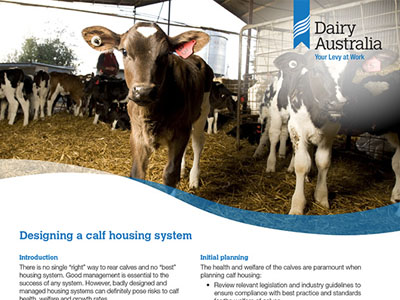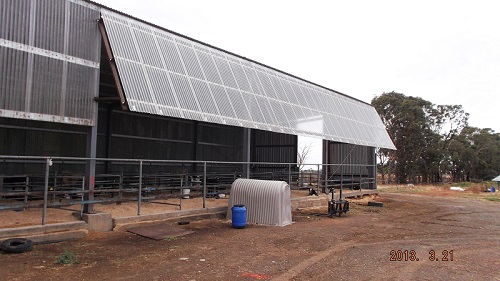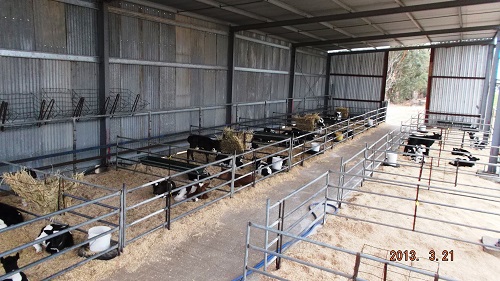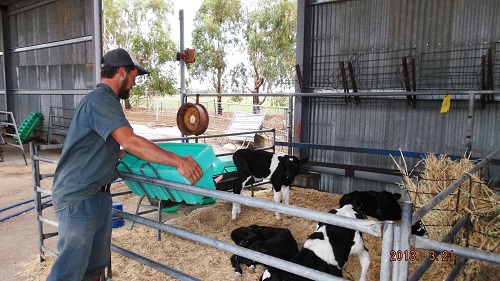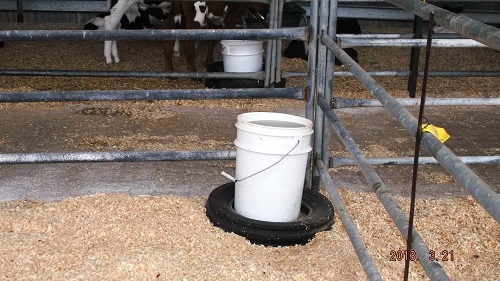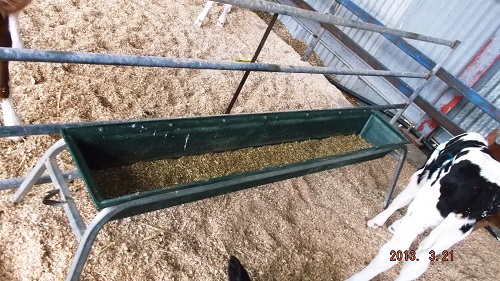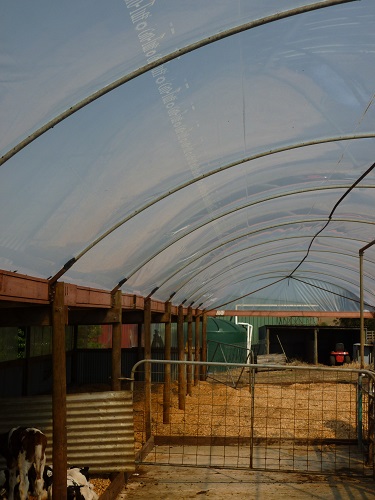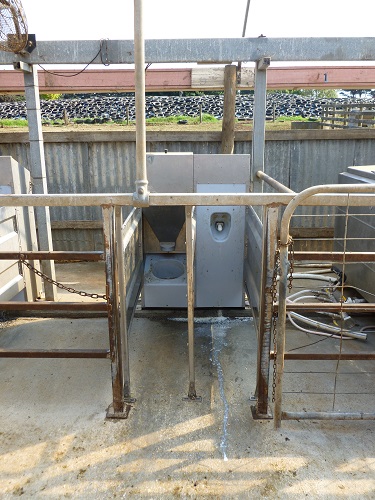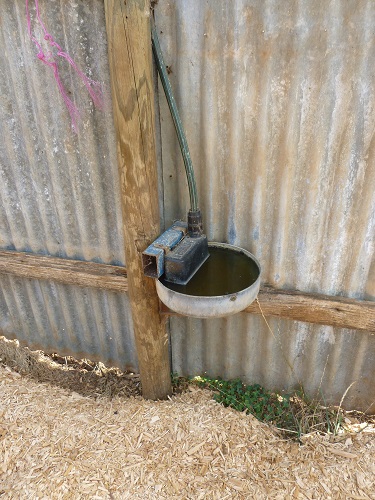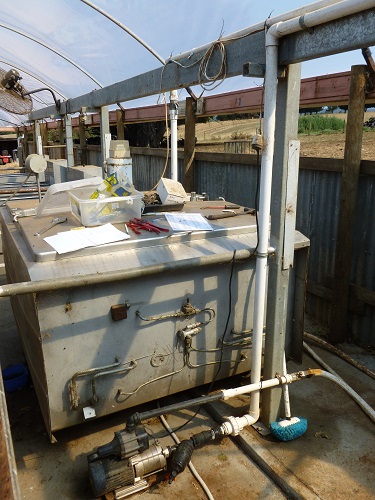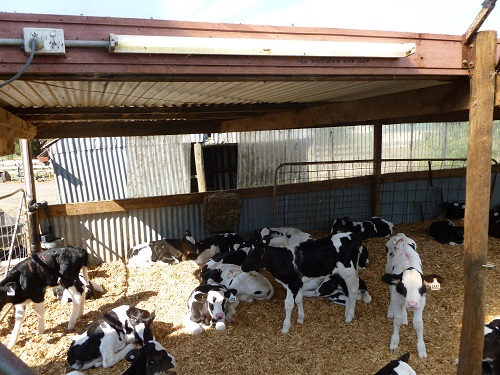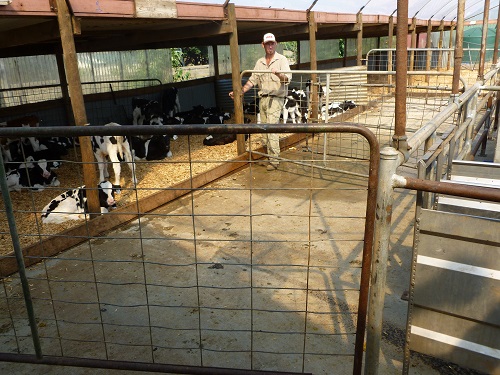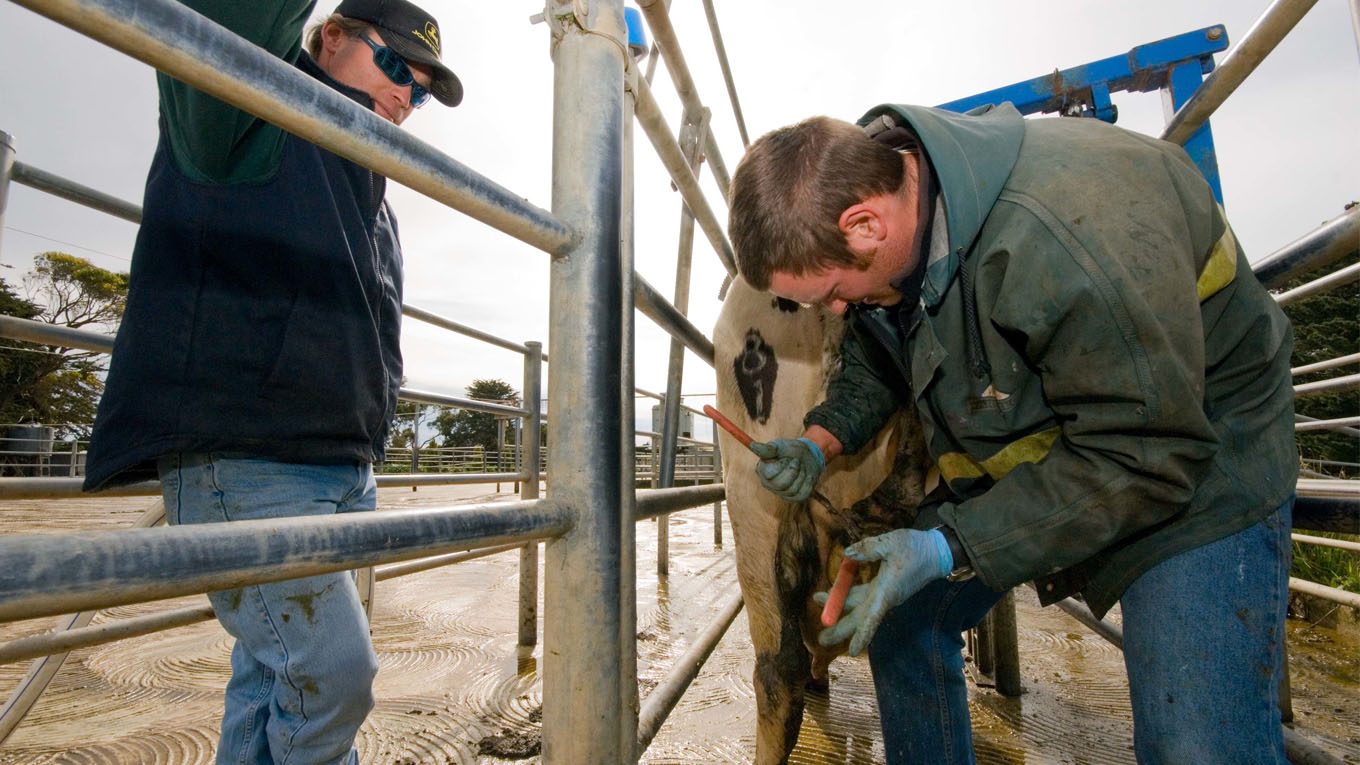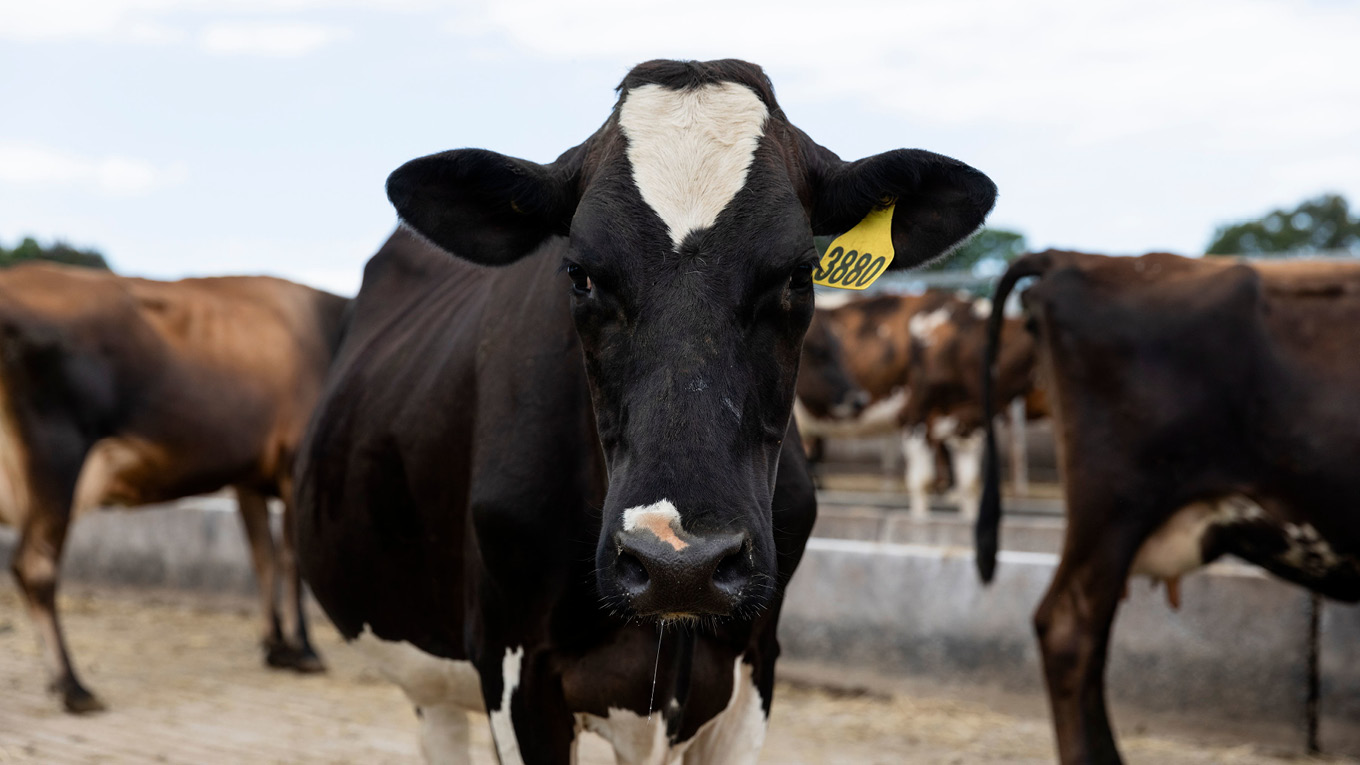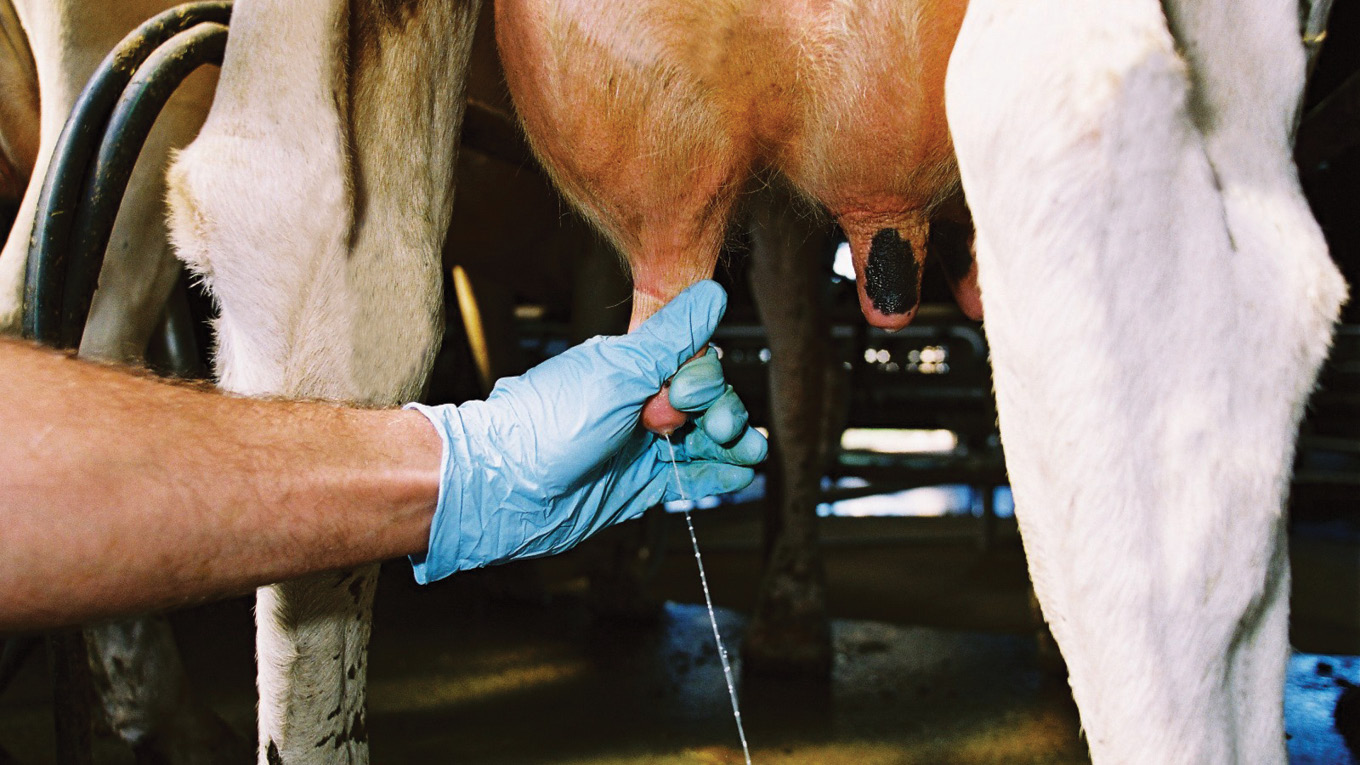Calf Housing
When selecting a calf housing system, you will need to consider your climate, budget, labour constraints and individual preferences. There is no single system that suits everyone’s needs. The impacts of a particular system on calf health and welfare also need to be considered. On this page you will find a comparison of different calf housing options, as well as some case studies that take an in-depth look at the options available.
Comparison of calf housing systems
This document provides an overview of the advantages and disadvantages of different calf housing systems.
-
Comparison of Calf Housing Systems factsheet
PDF, 2.54 MB
Case Studies
Calf housing does not have to be elaborate to be effective. This series of case studies takes an in-depth look at the calf housing options available to dairy farmers.
Case study: Lang family, Tatura, Victoria
Retro-fit conversion of a milking shed
The Lang family farm is located at Tatura, Victoria. The Langs took a five-year period to update this self-built shed, which was used as a milking shed until 1997. The project had a parts cost of $22,000.
This group housing system helps rear 260 calves per year in two batches; 70 in autumn and 160 in spring.
In the video below, Marcus Lang details the family operations and calf housing process.
-
Shed specifications
Shed structure
Materials used
- Galvanised iron on west wall and roof
- Plastic sheeting on east wall
- Cement flooring
Aspect
- Length of shed on east-west orientation
Dimensions
- 54.0 metres long x 9.0m wide x 4.4m high
Roof design
Pitch
- Difference in height/width: 90 centimetres in 9.0m
- Single pitch from west to east
Roof height
- Lowest point: 4.0m
- Highest point: 4.9m
Air space
Total air space
- 2,138 cubic metres
Air space per calf at peak
- 11.2m3
Ventilation
Type
- Passive
Cooling/airflow
- 6m wide gap in middle of west wall
- 3m wide gap in middle of south wall
- 3m wide gap in middle of north wall
- 2m wide plastic sheeting along the top of 24m of east wall
- Old building restricting air flow along 20m of east wall
Shed capacity
Maximum number of calves housed at peak
- 160 calves
Month of peak use
- September/October
Age of calves entering and leaving shed
- 0 to 24 hours. Calves are collected from the calving down area once each day.
Age/body weight of calves leaving shed (weeks/kilogram of body weight)
- Eight weeks of age, following weaning
Labour requirements (total man hours/day at peak use)
- Four man hours per day
Labour hours/50 calves at peak (total man hours/50 calves/day)
- 1.1 man hours/50 calves/day
Process
Calves are collected once per day after suckling dams for colostrum and an initial feeding of two litres of colostrum per calf.
The autumn configuration is to only use half the shed for rearing calves. This is 16 pens, each 3.0m x 3.5m in size. The rest of the shed is used for storing extra gates, troughs and teat feeders required for spring calf rearing.
The width of the aisle between the two batches of group pens, 2.0m, is only just sufficient for easy access and maneuvering of the bike and trailer carrying the milk from the dairy shed.
-
Pen specifications
Pen structure
Type
- Group pens (3.0m x 3.5m) for five calves
Wall height
- 800 millimetres. These are purpose-built gates.
Wall materials
- Solid/mesh
Front
- Gates with metal slots to join them. Removable for cleaning the shed.
Sides
- Gates with metal slots to join them. Removable for cleaning the shed.
Back
- Solid wall of west wall, gates with metal slots on east wall.
Process
Only half of the shed was fitted out for calf rearing since there were only 70 autumn calves, compared to 160 calves in spring. All pen gates can be easily removed to allow for complete cleaning of the calf shed, floor and walls using a pressure hose. Leaving the shed completely empty for several months between batches of calves also allows solar sterilisation of the shed.
Pen flooring
Type
- Concrete
Drainage
- Concrete slopes (0.5m in 24m) from north to south but there is no slope from east to west
Total floor space per pen
- 10.5 square metres
Floor space per calf at peak capacity
- 2.1m2 per calf
Bedding
Type
- Wood shavings
Minimum depth
- 150mm
Maintenance
- New wood shavings added weekly and entire bedding is removed following eight weeks of milk feeding.
Other
Soiled bedding is dumped in the manure pit at the bottom of the milking shed.
Feed and water
Milk feeding system type
- Teats in batches of five per pen
Milk delivery method
- Whole milk is transported from the milking shed in a tank located on a trailer and motorcycle
Hay
- In a hay rack in the middle of each pen
Pellets
- Calf muesli fed in a 2.5m-long trough in each pen
Water
- Water fed from a bucket, located inside a wheelbarrow tire for stability on the edge of each pen
Other
- Each calf is fed 3–4 litres of milk per day (twice daily) for three weeks then 3L/day (once daily) until weaning at 7–8 weeks of age
- Calves are offered ad-lib water and oaten hay from week one onward
- They are also fed calf muesli (20% protein) from week one onward with a gradual change over to calf rearing pellets (18% protein)
- They are weaned off milk once they are eating 1.5 to 2.0 kilograms of pellets per calf per day
- The calf pellets are stored in a silo, while the calf muesli is stored in bags.
-
Other infrastructure
Cleaning and disinfection
Type
- Lime is placed on the cement floor prior to covering it with new wood shavings
Other
- The calf shed has been located close to the farm house so the farm family can occasionally wander through it to check on calf health and welfare
Biosecurity
Boot/hand washing facilities
- No strict protocol, rely on common sense
Housing of sale calves
- Kept close to access road for once-weekly pickup by calf truck
Quarantine area for sick calves
- There are several calf igloos in which sick calves can be isolated away from the healthy calves
Colostrum management, record keeping system
- Eartags and date of birth of all calves and sick calves are recorded
Feed preparation and storage
Facilities (if in calf shed)
- Sink, fridge, storage cupboard, records/filing cabinet
Other
- Calves are fed pellets twice daily and pens with high intakes are noted for weaning off milk
Case study: Chris and Charmaine Bagot, Jindivick, Victoria
Purpose-built, low-cost greenhouse barn
Looking for a low-cost calf rearing system, Jindicick, Victoria, farmers Chris and Charmaine Bagot opted for a self-built greenhouse barn/hot house shed. The structure is built mainly from recycled materials and cost about $5,000, excluding the second-hand DeLaval automatic calf feeder.
Between 150 and 180 calves are reared as one group per year, with older calves removed in batches to a separate farm once they are weaned. The Bagots have a seasonal autumn calving pattern. In this video, Chris explains his purpose-built shed, commenting on the build, maintenance and benefits of this system.
In this video, Paul explains the new shed he designed to comfortably house 700 calves and make life easier for those looking after them.
-
Shed specifications
Shed structure
Materials used
- Walls: tin and laser light (recycled)
- Roof: tin and plastic-domed greenhouse roof (plastic over three-quarter inch pipe)
- Floor: concrete under feeders and deep wood chips elsewhere
- External yard: pasture with shelter trees
Aspect
- East to west (wind from south-west)
Dimensions
- Structure: 24 metres long x 5.45m wide x 3.2m high (domed section), 24m long x 4.15m wide x 2.15m high (roofed section)
- External yard/calf paddock: 75m x 30m
Roof design
Pitch
- Difference in height/width: domed roof (5.45m wide and 1.05m high) and extension roof (4.15m wide and 0.2m fall) - 5% slope
Roof height
- Lowest point: 1.95m (south wall of extension)
- Highest point: 3.2m (domed roof)
Air space
Total air space
- Under greenhouse: 392 cubic metres
- Under extension: 202m3
- Total: 594m3
Ventilation
Type
- Passive, assisted by two fans under greenhouse roof if required
Cooling/airflow
- Tunnel designed to pick up breeze
- South wall: 800 millimetre x 2m gaps in wall at 760mm height
- North wall - 400mm gap in wall entire length
Shed capacity
Maximum number of calves housed at peak
- 150
Month of peak use
- March
Age of calves entering and leaving shed
- Zero to 12 hours old
Labour requirements (total man hours per day at peak use)
- 1.5 hours/day once all calves started
Labour hours per 50 calves at peak (total man hours/50 calves/day)
- 30 minutes/50 calves/day
Process
- Calves collected at least twice daily
- Iodine dip navel
- Probiotic paste
- Tagged
- Colostrum tubed if needed,
- Put in small pen to get started on auto feeder.
-
Pen specifications
Pen structure
Type
- Smaller pens for start-up (up to 15 calves) then into communal pen with access to paddock
Wall height
- 760mm (width of sheet of tin)
Wall materials
- Front: mesh to feeders, tin to paddock
- Sides: removable mesh/gates
- Back: bottom 800mm tin, laserlite to roof
Removable
- Side walls swing back to wall and can be removed for cleaning
- Solid concrete gutter for scraping against south wall
Pen flooring
Type
- Concrete for feeding area, deep wood chips over dirt for the rest
Drainage
- Sloped concrete to central drain (to effluent pond)
Total floor space per pen
- 231 square metres in shed
Floor space per calf at peak capacity
- 1.5m2 in shed but calves also have access to 2,250m2 in paddock
Other
- Feed and water kept on concrete area
Bedding
Type
- Wood chips
Minimum depth
- 300mm
Maintenance
- Replaced every 3–4 weeks through season
Other
- Composted then spread on paddocks
Feed and water
Milk feeding system type
- DeLaval automatic feeder
Milk delivery method
- Fourth line in dairy to refrigerated vat
- Pumped underground to calf shed
- Non-refrigerated vat in calf shed filled up every 2–3 days
- Automatic milk feeders draw from this
Hay
- Wire baskets hung from wall, 500mm high
Pellets
- DeLaval auto feeders filled up by bucket
Water
- Small drinking dishes on walls
- Piped water to clean-up/preparation area
-
Other infrastructure
Cleaning and disinfection
Type
- Continuous, run as a mob
Other
- Very low mortality rate
Biosecurity
Housing of sale calves
- All bull calves are kept
Quarantine area for sick calves
- Small pen next to calf shed (rarely used)
Other
- Book kept in shed next to feeders
- DeLaval reports and exception list checked daily
Feed preparation and storage
Facilities (if in calf shed)
- Wheel barrow to transport pellet buckets
-
Layout
Layout of calf housing shed at Bagot.
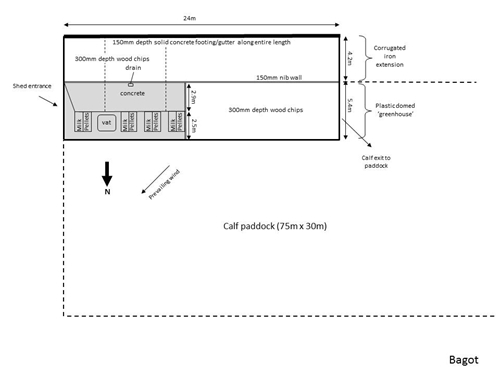
Case study: Paul Bennett, Elizabeth Town, Tasmania
Purpose-built, open group housing – custom design and a standard kit
At Ashgrove Farm, located at Elizabeth Town, Tasmania, Paul Bennett rears 1,300 calves per year in two batches. For his calf housing system, Paul designed a purpose-built shed that could make use of standard gates and railings. The shed was built from a standard kit and the project cost was $150,000 all up.
In this video, Paul explains the new shed he designed to comfortably house 700 calves and make life easier for those looking after them.
-
Shed specifications
Shed structure
Construction materials
- Walls: colourbond on north and south ends. No walls on west and east sides
- Roof: colourbond with one-metre wide skylight every five metres
- Floor: concrete and dirt
Aspect
- Oriented north-south, providing sun in the morning and afternoon into calf pens
- Prevailing winds from the north-west
Dimensions
- Structure 70m long x 15m wide x 4.8m high
Roof design
Pitch (1:4)
- Difference in height/width: 15%
Overhang eves
- 1,000 millimetres
Roof height
- Lowest point: 3.4m
- Highest point: 4.5m
Air space
Total air space under roofline
- 4,200 cubic metres
Air space per calf at peak (6-8m3)
- 6m3
Ventilation
Type
- Passive
Cooling/airflow
- No walls along sides of shed
- Solid gates on windward side (west) to 1,200mm in height
Shed capacity
Maximum number of calves housed at peak
- 728 calves total
- Up to 26 calves per pen (mostly 23 to 25 calves per pen)
Month of peak use
- September
Age of calves entering and leaving shed
- 24 hours to 10 weeks of age
Labour requirements (total man hours per day at peak use)
- Two people x 1.5 hours per day
- A single person can feed 700 calves in an hour once all the calves are self-feeding
Other
- Calves brought in during early afternoon and tubed
-
Pen specifications
Pen structure
Type
- Group
Wall height
- 1,000mm
Wall materials
- Front: rails
- Sides: solid on concrete, two swinging sheep gates (2.15m) on bedding
- Back: two sheep yard panels, solid to west
- Removable: crush frame 'bows' concreted in
Pen flooring
Type
- Concrete and deep litter over dirt
Drainage
- Concrete drains to centre walkway (about 2% slope)
- Centre walkway drains to south end of shed (5% slope)
Total floor space per pen
- 35 square metres
Floor space per calf at peak capacity
- 1.35m2/calf
- Usually 23 calves per pen, so 1.5m2/calf
Bedding
Type
- Sawdust
Minimum depth
- 300mm
Maintenance
- Scrap out at end of season
- Completely replace between batches
Other
- Used bedding composted and given to gardeners
Feed and water
Milk feeding system type
- Teat feeders made to order
Milk delivery method
- Pumped from tank on trailer
Hay
- Wire net on fence
Pellets
- Ad-lib supply from hopper in each pen
- Fed by standard herringbone set-up from a silo into cut away 25-litre drum, 600mm off the floor
Water
- Nipples in each pen
Other
- 4.5L per calf (some over feed)
- Feeders have a mark in to ensure staff give the correct amount
-
Other infrastructure
Cleaning and disinfection
Type
- Batch
Other
- Aim to move batches further apart once CSD is shifted
Biosecurity
Boot/hand washing facilities
- Hose at northern end of shed
Housing of sale calves
- All calves are reared, including males
Sick calves quarantine pen
- Moved to bottom pen (very few problems)
Other
- Colostrum tube fed twice in first 24 hours
- Records kept on whiteboard in shed and in note book
- No tags on calves at this age
Feed preparation and storage
Facilities (if in calf shed)
- Portico to be built at northern end of shed for storage
Case study: Nigel Brock, Montana, Tasmania
Purpose-built, low-cost, free-standing sheds
Nigel Brock is based at Montana, Tasmania. His calf housing system features eight purpose-built sheds for 30 calves per shed.
The project cost him $15,000 for fencing, plus eight home-built sheds at $2,000 each. The farm's calving pattern is seasonal, rearing 240 calves per year.
In this video, Nigel talks about the low-cost solution he devised to house his calves.
-
Shed specifications
Shed structure
Construction materials
- Walls: corrugated iron on timber frame
- Roof: corrugated iron on timber frame
- Floor: sawdust over soil
- External yard: pasture
Aspect
- Facing east
Dimensions
- Structure: Each shed is six metres long x 3m wide x 2.5m high (18 square metres)
- External yard/calf paddock: 22m x 200m for each shed (4,400m2)
Roof design
Pitch
- Difference in height/width: 0.5m:3m = 1:6 (single slope to rear)
Roof height
- Lowest point: 2m
- Highest point: 2.5m
Air space
Total air space
- Inside only – 42 cubic metres
Air space per calf at peak
- Inside only – 1.4m3
Ventilation
Type
- Passive
Cooling/airflow
- Open on east wall
Shed capacity
Maximum number of calves housed at peak
- 30 per shed
- 240 calves across eight sheds
Month of peak use
- August/September
Age of calves entering and leaving shed
- Enter at seven to 10 days old
- Leave at 12 weeks old
Labour requirements (total man hours per day at peak use)
- One hour per day to feed 240 calves with one 450-litre Calfateria feeder
A 1,000L tank to be installed at site to avoid towing Calfateria back to main dairy twice a day for each feeding
-
Pen specifications
Pen flooring
Type
- 150mm of sawdust
Total floor space per pen
- 18 square metres
Floor space per calf at peak capacity
- 0.5m2 (internal)
Other
- 4,400m2 per 30 calves
Bedding
Type
- Straw, shavings, chips, sand
Minimum depth
- 150mm of sawdust
Maintenance
- Top-up at start of the season
Feed and water
Milk feeding system type
- 450L Calfateria does three batches
- 5L/calf per day
Milk delivery method
- Calfateria transport to paddock
- Installing a 1,000L tank on ute to transport milk from dairy to calf paddock
Hay
- Wire net on fence
Pellets
- Troughs
Water
- Trough in paddock
-
Other infrastructure
Cleaning and disinfection
Type
- Single batch only on the area then rested for eight months until next season
Other
- Sheep graze the area when calves are not using it
Biosecurity
Access restrictions
- Try not to drive vehicle into paddocks (except with Calfateria)
Housing of sale calves
- In a shed at the dairy
Quarantine area for sick calves
- Taken back to a shed near the dairy
Case study: Dornauf Dairies, Elizabeth Town, Tasmania
Purpose-built, centralised group housing with computer-controlled feeders
Dornauf Dairies runs four farms at Elizabeth Town, Tasmania. Centralising the dairy's calving system helped reduce labour requirements and increase both biosecurity and calf comfort.
This purpose-built shed was provided as a kit from a local shed builder. The dairy rears between 550 and 600 calves per year, with a calving pattern of 150 to 180 in autumn (April/May) and 400 in spring (August/September).
In this video, Chris Dornauf gives a walk-through of his purpose-built shed that houses 400 calves and features computer-controlled feeders for both milk and grain.
-
Shed specifications
Shed structure
Construction materials
- Walls: zinc aluminium
- Roof: zinc aluminium and skylights
- Floor: concrete/gravel
- External yard: pasture
Aspect
- Facing west to east
- Wind from north-west
Dimensions
- Structure: 42 metres long x 20m wide x 5m high (4.2m at eaves)
- External yard/calf paddock: 12 x 0.3-hectare areas
Roof design
Pitch
- 8% (1:12.5)
Roof height
- Lowest point: 4.2m
- Highest point: 5m
Air space
Total air space
- 3,780 cubic metres
Air space per calf at peak
- 9.45m3
Ventilation
Type
- Passive through open doors
Cooling/airflow
- Three large roller doors to west
- One large roller door (3m) to east
- Six small roller doors (2m) to sides
Shed capacity
Maximum no calves housed at peak
- 400
Month of peak use
- September
Age of calves entering and leaving shed
- 24 hours to 60 days
Labour requirements (total man hours per day at peak use)
- One person takes six hours at peak (not including fetching milk and new calves)
Labour hours per 50 calves at peak (total man hours/50 calves/day)
- 0.75 hours/50 calves/day
Other
- Lighting: Three metal halide globes used 24 hours per day at peak to encourage feed intake
-
Pen specifications
Pen structure
Type
- Group of 30 to 35
Wall height
- 1,000mm
Wall materials:
- Front: welded mesh on steel frame
- Sides: welded mesh on steel frame
- Back: zinc aluminium walls with 2m x 3m roller door
- Removable: Side walls swing back to wall and can be removed for cleaning
Other
- Gates on either side of calf feeding units
- Can drive ute to pens through central race for unloading
Pen flooring
Type
- Concrete and gravel covered with deep wood shavings
Drainage
- Drainage of concrete at nib wall, 2-3% slope on concrete to nib wall
Total floor space per pen
- 52 square metres
Floor space per calf at peak capacity
- 1.7m2
Other
- Feed and water kept on concrete area
Bedding
Type
- Pine post peelings (wood)
Minimum depth
- 150mm
Maintenance
- Completely replaced for each batch
Other
- Used bedding composted and used as mulch on neighbouring berry farm
Feed and water
Milk feeding system type
- DeLaval automatic feeding units
- 12 units servicing 12 pens
- One controller per four units (not networked)
- Calves fed up to 6L/day (2L every eight hours)
Milk delivery method
- Transported by 1,000L container to two refrigerated 3,000L vats in calf shed (milk lasts up to 30 days)
- Fed milk only: colostrum, antibiotic milk and sale milk if run out
Hay
- Hay racks in paddocks
Pellets
- Auto feeders feed up to two kilograms per calf
- Manually top-up feeders
Water
- Pig nipples in each pen
- Some paddocks have troughs
Other
- Hot water service, wash drum and chemicals
- Underfloor pipes to supply refrigerated milk to feeder units
-
Other infrastructure
Cleaning and disinfection
Type
- Batch
Other
- Sometimes batches follow each other (pens cleaned in between)
- Lime over gravel, formalin wash over concrete parts
Biosecurity
Access restrictions
- Shed door locked
- Gate locked to stop entry to area from public road
Housing of sale calves
- Housed in another separate shed on another property
Quarantine area for sick calves
- Separate pen made at end of shed
Other
- Closed herd but mixing calves from four different farms
Feed preparation and storage
Facilities
- Sink, fridge, storage cupboard, records/filing cabinet
